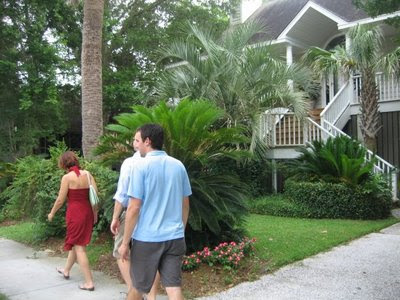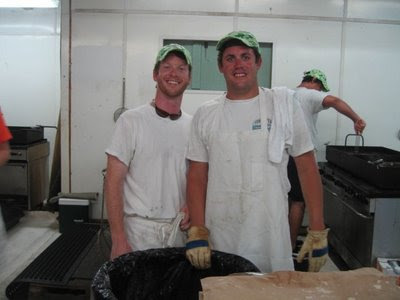
Steve and Melissa at the stove.
Cooking is like architecture; cooks are like designers. The same ingenuity and reverence for material and craft are key to both. It is that inventive spirit that draws me equally to design and the kitchen and it is what the two can tell us about ourselves that is so intriguing. How we build and how we eat are inextricably linked to how we live. French historian Pierre Gaxette once said, "La cuisine is not a bad observatory for studying la grande histoire." The same is certainly true of observing cities and buildings.
Matt and I just spent several days in Charleston, South Carolina with our friends Steve and Melissa. They are a couple who represent both sides of this architecture/food coin.
Melissa is an architectural historian who specializes in vernacular architecture. She is a reader of culture. She can analyze layers of history, research a structure and its surroundings, and put a building into the greater context of the human experience. She seeks to understand place and meaning and to articulate those elements to the rest of us. And she does it beautifully.
Melissa introduced me to the writing of MFK Fisher. The way Fisher writes about food is the way, I hope, to write about design. In her autobiography, The Gastronimcal Me, published in 1943, Fisher explains why she chooses food over other seemingly "important" topics:
"People ask me: Why do you write about food and eating and drinking? Why don't you write about the struggle for power and security, and about love, the way others do?
They ask it accusingly, as if I were somehow gross, unfaithful to the honor of my craft.
The easiest answer is to say that, like most other humans, I am hungry. But there is more than that. It seems to me that our three basic needs, for food and security and love, are so mixed and mingled and entwined that we cannot straightly think of one without the others...
I tell about myself, and how I ate bread on a lasting hillside, or drank red wine in a room now blown to bits, and it happens without my willing it that I am telling too about the people with me then and their deeper needs for love and happiness.
There is food in the bowl, and more often than not, because of what honesty I have, there is nourishment in the heart, to feed the wilder, more insistent hunger. We must eat. If, in the face of that dread fact, we can find other nourishment, and tolerance and compassion for it, we'll be no less full of human dignity."
While Melissa studies vernacular architecture, Steve, it could be said, is a vernacular chef. Self taught over the years, he is equally inspired by place, season, and indigenous resources. While on a trip to Maine last year, he whipped together a hearty fish chowder from local ingredients. On a recent spring day, he made a dish from the season's first tender peas. He is constantly tinkering with new ingredients and crafting recipes.
I've learned a great deal by watching Steve in the kitchen. There is an economy to his cooking—he is frugal and efficient—yet in his simple and smart approach he generates incredibly flavorful and rich dishes. He is the one who taught me how to make three meal out of one roast chicken. (You can also be inspired by Steve by signing up for his Recipemail.)
During our stay in South Carolina, we brought along some basic pantry items: olive oil, sea salt, soy sauce, honey, garlic, etc. Steve then discovered the local resources: A farmer's market in downtown Charleston for fresh herbs and shrimp; a local store supplying short ribs and fresh fish.
He also used every bit of food available and wasted nothing. He took leftover brown rice from dinner and turned it into rice cakes for breakfast by adding eggs, seasonings, and crushed up stale crackers that had been left out overnight by accident.

Rice cakes.
Steve purchased a nice fillet to mariante for gravalox. He asked the fishmonger for leftover salmon heads. The man offered Steve an entire head plus the spine for free. "Sometimes when you ask for a head, they'll just give you all of this," he said when he got home, referring to the remains of a whole fish.

The fish head with the spine.
Sloppy butchering left lots of meat along the spine, so Steve broiled it and picked off the flesh to make salmon cakes. He then used the remaining bones for fish stock (which eventually became a red curry soup with buckwheat soba noodles). He created three meals—salmon cakes, gravalox, and curry stew—by purchasing just one fillet of salmon.

Steve pulling the meat off the fish.

The fish yielded about a pound of salmon meat. Steve combined it with shaved zucchini, egg, bread crumbs, and seasonings to make salmon cakes that we took out to the beach in a cooler and ate for lunch.



Marinating the fillet to make gravalox. We ate this on bagels one morning for breakfast.

The fish stock.
While we (and by "we" I mean Steve and Melissa) cooked a lot, it's impossible not to go out for a few meals while in the low country. The first stop on the way into town was my husband's favorite BBQ joint, Melvin's. He grew up on this stuff. The pork is cooked over hickory and tossed in a yellow sauce made with mustard and vinegar.



No trip here is complete without boiled peanuts from a roadside stand. My husband turned me onto these. When prepared well, they taste more like salty beans than peanuts. You scoop them out of a hot vat into paper cups.

One night we drove onto Sullivan's Island for a burger at my favorite bar, Poe's Tavern (Edgar Allen Poe was stationed at Fort Moultrie in 1828 and his short story, The Gold-Bug, was set here.) Sullivan's Island is a spectacular place, surrounded by the Atlantic and the Charleston harbor. The houses are primarily bungalows and cottages, with a few oversized new-builds mixed in.

This small bungalow shrouded by palms is typical of the houses on Sullivan's Island. (So, sadly, is the Range rover in the driveway. This island isn't cheap)

A dog stands guard on the steps of a Sullivan's Island home.

An atypical concrete house on Sullivan's Island. This is one of my favorite places, built after hurricane Hugo levelled the stick-built home here.

Poe's Restaurant

The "Gold Bug" burger comes with cheese.
On the way to Poe's, we noticed a sign on the side of the road for the annual volunteer firemen fish fry. One thing I have learned over the years is that you should never miss a local church dinner or a fish fry. We decided to come back the next night.

We weren't disappointed. The fish was incredible. Crispy, flavorful, with just the right blend of flour, cornmeal, salt, and pepper in the crust, it was accompanied by coleslaw and hush puppies. The grand total for the meal: $8. Cold draft beer was only $2.

Melissa, Steve, and Matt walking to the fish fry.

A band played under a tent on the lawn. Several more tents housed beer and hot dogs, while a large tin-roofed pavillion sheltered the diners. (A good thing since a serious thunderstorm rolled in off the water that night.)

A hand-painted sign from a past fish fry.

The overstuffed fish fry platter.

Can this be right? $8 for three pieces of fish, coleslaw, hush puppies, and just $2 for a cold draft beer?

Close up on the fish. Notice the nice mix of cornmeal, flour, and cracked pepper.

Mmmm. Hush puppy.
We were curious about how this fish turned out so crisp and tasty, so Steve and I asked to pop back in the kitchen. The cooks told us that they use whiting, a mild fish that is often overlooked, Steve believes, because it's not marketed as heavily as other species. The fish batter was store-bought, made by a North Carolina company called House of Autry. The hush puppy batter came from them as well.

Volunteers plate the food.

Behind the line of volunteers, the cooks fry the whiting in large vats of oil.



I also picked up some of my favorite Southern food while in Charleston. I always buy a five-pound bag of White Lily flour, which is made from winterwheat and is the perfect consistency for baking fluffy breakfast biscuits (the best recipe I have found for homemade biscuits is in the Gourmet cookbook).
And one of my all-time favorite southern appetizers—first introduced to me by my mom— is hot pepper jelly served with cream cheese and crisp crackers. It reminds me of growing up in Virginia.



